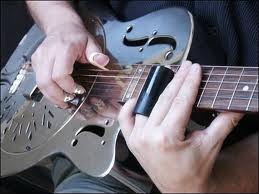
|
Slide Guitar LessonsSlide guitar lessons help you re-orient yourself to an entirely different approach to playing the guitar. It is so different replacing all the left hand fingering that you know with a brass or glass slide on one of your left hand fingers, and even that choice of where to put the slide has consequences. Because you’ll need at least one finger to dampen the resonance behind the slide, you can place the slide on your second, third, or fourth finger, and the one you choose will go a long way towards determining whether you’ll be playing a hybrid style of fretting notes in some passages, and using the slide in others. Because the slide is a straight shot across one fret, it is imperative to either know the fretboard incredibly well and see segments where fragmented chords intersect or to become an expert in open "E" or open "G" tuning, or even some other custom tunings. It is also mandatory that you learn appropriate damping and blocking techniques.
How the notes ring together is one of the most attractive elements of this type of guitar playing, and it requires tremendous fretboard knowledge including the ability to expand that fretboard knowledge to understand the landscape when multiple strings are tuned to different pitches. The use of open tunings helps to create pre-formatted chord groups in open string clusters, making it that much easier to grab the notes for the sound you want. Over time you will gain a great deal of experience as to how you want your slide playing to sound, and a large part of that is in dealing with different resonances that are developed from the composition of the slide. Different materials create different sounds, as do the density of the material which is usually expressed in terms of wall thickness. So there are audible differences between thin and thick walled glass slides, thin and thick wall brass slides, thin and thick wall ceramic slides, etc. Don’t kid yourself on this one. There are several demanding techniques you must master to make this style of playing sound good. Don’t just think you put a slide on a finger and you’re off to the races. Slide guitar lessons will help equip you with everything you must know to play this style well, and the great thing about these techniques, is that they work on any guitar with steel strings. That means you can use this with both electric and acoustic guitar playing. Learn how to be the best slide guitar player possible with slide guitar lessons from the Guitar Lesson Expert.
|

melodic rock solo
blues rock solo
Hendrix style chordal solo
fingerstyle accompaniment
slide guitar solo
advanced fingerstyle
with violin solo
rock solo intro
fingerstyle accompaniment
© WhiteSpace Records
all song fragments
used by permission
all pieces are excerpts from
"R & D" by Rebeca & David
|
© 2010 All rights reserved.
Guitar Lesson Expert 1949 Valley Rd, Studio A Oceanside, CA 92056
Phone: (760) 621-5939


